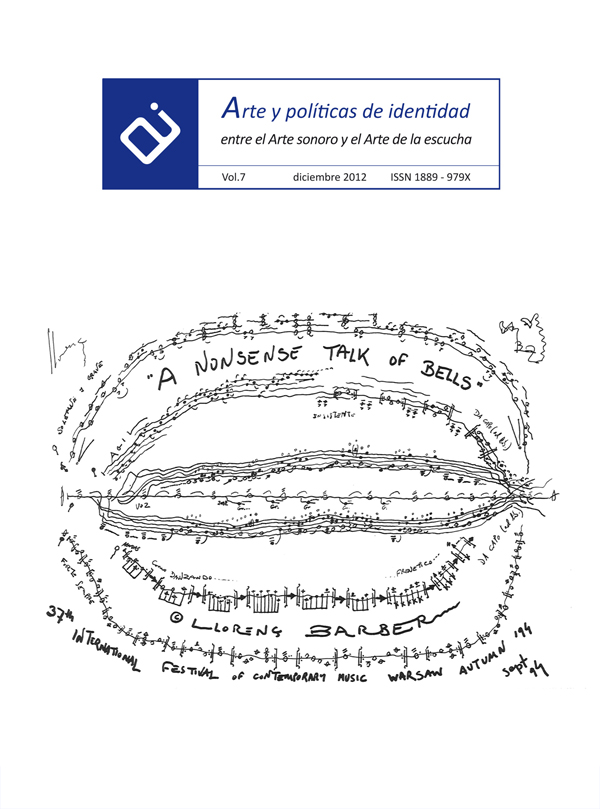El silencio audible: De la escucha asombrada a la escucha generativa
Abstract
The present paper addresses the issue of the implication of silence on hearing and its epistemological contribution to culture. The main objective of the paper is to prove that silence plays a fundamental role at a perceptive and creative level becoming a powerful tool in creating and interpreting meaning. In order to show the extent of these points, the article is divided into three parts: the treatment of the inherent link between silence and hearing, the roots of astonished hearing in literature and finally an analysis of some proposals by the artist Felix Hess, whose work is closely linked to the principles transmitted in the aforementioned points. This highlights the validity of a notion that has scarcely ever been considered under the variables proposed here.
Downloads
-
Abstract632
-
PDF (Español (España))728
References
Bruneau, T. J. (1973). Communicative silences: forms and function. TheJournal of Communication, 23, 17-46.
Camus, A. (2012). Las Bodas. El Viento de Djémila. Recuperado el 17 de abril de 2012 de http://es.scribd.com/doc/550237/Albert-Camus-Bodas-pdf#outer_page_4
Darò, C. (2009). Un debate cultural sobre Muzak. En R. Rodríguez López (Ed.), Foro Mundial de Ecología Acústica: Megalópolis sonoras. Identidad cultural y sonidos en peligro de extinción (pp.437-451). México: Fonoteca Nacional.
Dauenhauer, B. P. (1976). Silence. An Intentional Análisis. Research in Phenomenology, 6, 63-83.
Garriga, R. (2008). Haciendo Tiempo. Valencia: Universitat Politècnica de València.
Gómez de la Serna, R. (1962). Total de Greguerías. Madrid: Editorial Aguilar.
González, C. (1984). Artículos sobre cuenca. Carboneras de Guadazaón: El Toro de Barro.
Guardans, T. (2009). La verdad del silencio. Por los caminos del asombro. Barcelona: Herder Editorial.
Hess, F. y Schulz, B. (2001). Felix Hess: Light as Air. Heidelberg: Kehrer.
Jaworski, A. (1993). The power of silence: social and pragmatic perspectives. London: Sage.
Jaworski, A. (ed.) (1997). Silence: interdisciplinary perspectives. New York: Mouton de Gruyter.
Kafka, F. (2009). Relatos Completos I. Argentina: Losada.
Le Breton, D. (2007). El sabor del mundo. Una antropología de los sentidos. Buenos Aires: Nueva Visión.
Le Breton, D. (2009). El silencio. Aproximaciones. Madrid: Sequitur.
Le Breton, D. (2011). El silencio y la palabra contra los excesos de la comunicación. Buenos Aires: Ediciones Nueva Visión.
López, J. G. (2009). La escucha múltiple. Quintana, 8, 309-312.
Maillard, C. (1997). Experiencia estética y experiencia mística, Revista interdisciplinar de filosofía, 2: 177-191.
Nöelle-Neumann, E. (1977). La espiral del silencio. Opinión pública: nuestra piel social.Barcelona: Paidós.
Panikkar, R. (1974). The Silence of the Word: Non-dualistic Polarities. Cross Currents,24, 154-171.
Pezeu-Massabuau, J. (1984). Au Japon: les voix et les voies du silence. Corps écrit, 12.
Prochnik, G. (2010). In Pursuit of Silence. Listening for Meaning in a World of Noise. United States: Doubleday.
Ramírez, E. (1928). Los murmullos, sones y cánticos del campo, Blanco y Negro, 08/07/1928, 5-10.
Saville-Troike, M. (1985). The place of silence in an integrated theory of communication, Tannen, D. –
Saville-Troike, M., (eds.): 3-18.Steiner, G. (1978). Lenguaje y silencio. Ensayos sobre la literatura, el lenguaje y lo inhumano. Barcelona: Editorial Gedisa.
Valesio, P. (1985). A Remark on Silence and Listening. Rivista di Estetica, 26, 17-44.
Virilio, P. (2000). El procedimiento silencio. Barcelona: Editorial Paidós.
Voegelin, S. (2010). Listening to Noise and Silence. Towards a Philosophy of Sound Art. London: Continuum.
Works published in this journal are subject to the following terms:
- The Service of Publications from the University of Murcia (publishing house) keeps the published works’ copyrights, and favors and allows the reuse of these works under the license indicated in point 2.
- Works are published in the journal’s online edition under the license Creative Commons Reconocimiento-NoComercial-SinObraDerivada 3.0 España(texto legal). They can be copied, used, disseminated, transmitted and publicly exhibited, as long as: i) the author and original source of publication are cited (journal, publishing house and work’s URL); ii) they are not used for commercial purposes; iii) the existence and specifications of this license are mentioned.
3. Conditions for auto-file. It is allowed and encouraged that authors share electronically their pre-print version (the pre-reviewed version) and /or post-print version (the reviewed and accepted version) of their Works before the publication, since it promotes its circulation and dissemination. RoMEO color: green.










